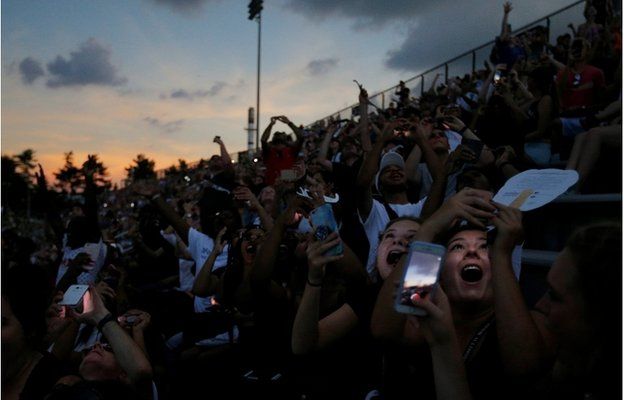
A total solar eclipse has wowed the US.
A huge shadow cast by the Moon as it passed in front of the Sun swept across the nation, from Oregon in the west to South Carolina in the east.
Millions of people moved to get into the path of darkness, putting on their protective glasses to gaze at the sky in wonder.
It was the first total solar eclipse visible from America's lower 48 states in 38 years, and the first since 1918 to track from coast to coast.
As it happened: American eclipse
When is the next eclipse in my country?
Why are eclipses so rare?
Meet the man addicted to eclipses
Tips on viewing eclipses
CarbondaleImage copyrightREUTERS
Image caption
Those who went to Carbondale were not disapointed
The TrumpsImage copyrightAFP
Image caption
US President Donald Trump and First Lady Melania Trump saw a partial eclipse in Washington DC
The spectacle started in Oregon at 10:16 local time.
Skywatchers gathered on the coast witnessed the Sun's disc being completely obscured by the Moon for two minutes.
But just before and just after totality, they also got to see some of the classic features of a total solar eclipse.
These included "Baily's beads" which arise as the last shafts of sunlight drive through valleys on the Moon; and the "Diamond Ring", which is the single brilliant point of light that signals the beginning and end of totality.
From Oregon, the eclipse shadow raced on through Idaho, Montana, Wyoming, Nebraska, Kansas, Iowa, Missouri, Illinois, Kentucky, Tennessee, Georgia, North Carolina, South Carolina. It was a journey that took roughly 90 minutes.
PinholeImage copyrightEPA
Image caption
Using a "pinhole camera" was the safest way to view the Sun and Moon action
ISS viewImage copyrightNASA
Image caption
Space station astronaut Paolo Nespoli pictured the Moon's shadow from orbit
Small towns along the path were inundated with visitors. So were the National Parks.
In Carbondale, Illinois, city authorities billed the location as the "Eclipse Crossroads of America" because it would enjoy totality both on Monday and when the next US eclipse occurred in 2024.
As anticipated, it proved to be a huge magnet to visitors who made good use of the more than 60,000 extra car parking spaces organised for the day.
The area also enjoyed the longest period of darkness, lasting two minutes and 40 seconds.
Map: Path of total eclipse across the United States
CarbondaleImage copyrightGETTY IMAGES
The Atlantic coastal city of Charleston was the final big urban area tasked with saying goodbye to the eclipse. It experienced the full shadow at 14:47 local time (18:47 GMT; 19:47 BST).
Although, the US had exclusive rights on totality, a partial eclipse was visible across all of North America and the north of South America.
Parts of western Europe were also set to see the Moon take a little chunk out of the Sun at the end of the day just before the star dipped below the horizon.
The next total solar eclipse on Earth is on 2 July, 2019, over the South Pacific, Chile, Argentina.
Hi! I am a robot. I just upvoted you! I found similar content that readers might be interested in:
https://www.nsbcnews.com/story/20170821-solar-eclipse-2017-americans-gaze-at-sky-spectacular
Downvoting a post can decrease pending rewards and make it less visible. Common reasons:
Submit
u r robot xD
Downvoting a post can decrease pending rewards and make it less visible. Common reasons:
Submit